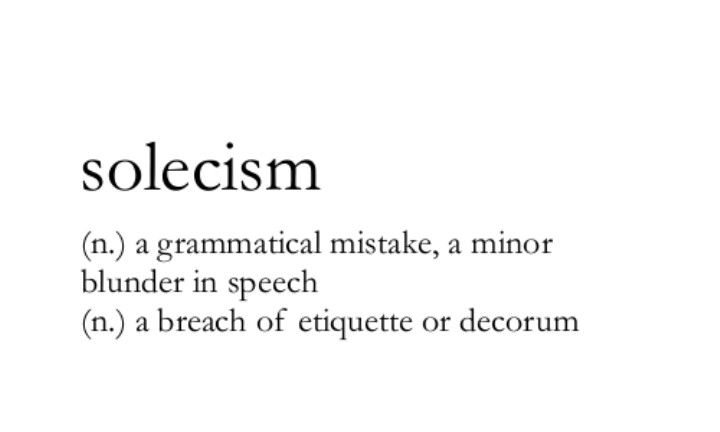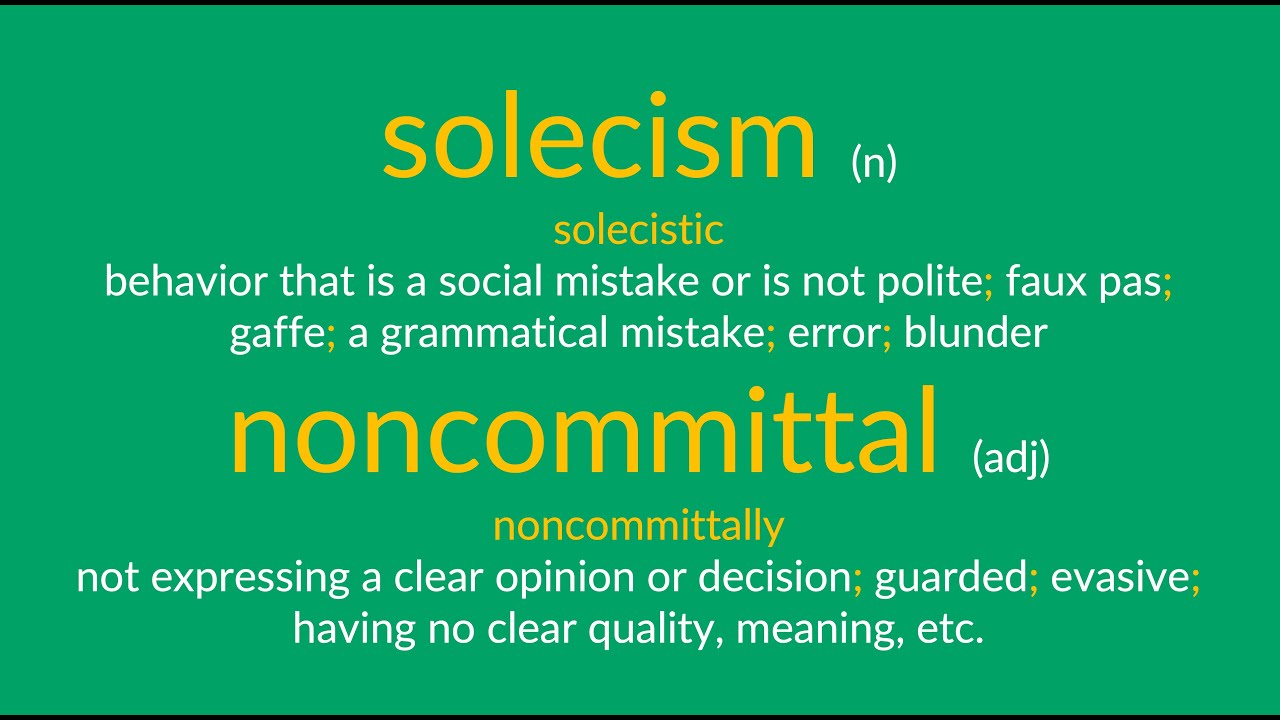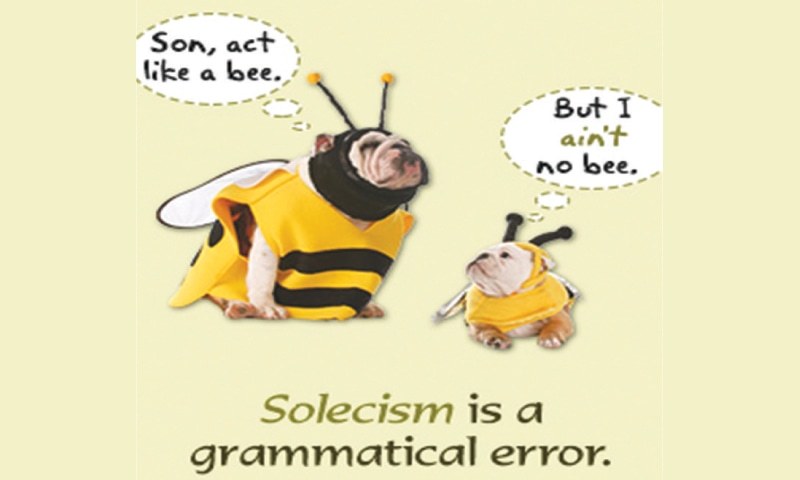Solecism mistakes happen to everyone, even the smartest people you know. You’ve probably made grammar errors without knowing it, and that’s completely normal.
The word “solecism” sounds fancy, but it’s just a term for grammar mistakes that break language rules.
Most people don’t realize they’re making these errors daily in their writing and speech.
Understanding solecism will help you communicate better and avoid embarrassing mistakes.
This guide will show you exactly what solecism means, give you real examples, and help you fix common grammar problems.
You’ll learn everything you need to know about avoiding these language mistakes.

What Is Solecism? (Complete Definition)
Solecism is a grammar mistake that breaks the normal rules of language.
The word comes from ancient Greek, referring to people from Soloi who spoke incorrect Greek.
A solecism happens when someone uses wrong grammar, word order, or sentence structure.
These mistakes make sentences sound awkward or confusing to readers.
Grammar experts define solecism as any deviation from standard language rules.
You might think of it as a “language crime” that makes communication harder.
Most solecism errors involve mixing up verb tenses, wrong pronouns, or bad sentence structure.
The important thing is that these mistakes make your writing less clear and professional.
Types of Solecism in English Grammar
Subject-Verb Agreement Errors
Subject-verb agreement solecism happens when verbs don’t match their subjects.
This is one of the most common grammar mistakes people make.
Wrong: “The group of students are going to the library.”
Right: “The group of students is going to the library.”
The subject “group” is singular, so it needs the singular verb “is.”
Many writers get confused when there’s a prepositional phrase between the subject and verb.
Wrong: “One of the books are missing.”
Right: “One of the books is missing.”
Remember that “one” is the subject, not “books.”
Pronoun Reference Problems
Pronoun solecism occurs when pronouns don’t clearly refer to their antecedents.
This creates confusion about who or what you’re talking about.
Wrong: “John told Mark that he was late.”
Right: “John told Mark that Mark was late.”
The pronoun “he” could refer to either John or Mark.
Clear pronoun reference makes your writing easier to understand.
Wrong: “They say it will rain tomorrow.”
Right: “Weather forecasters say it will rain tomorrow.”
Don’t use vague pronouns like “they” without clear references.
Tense Consistency Errors
Tense solecism happens when you mix different time periods in one sentence.
This confuses readers about when things happened.
Wrong: “She walked to the store and buys milk.”
Right: “She walked to the store and bought milk.”
Keep your verb tenses consistent within sentences and paragraphs.
Wrong: “I am reading a book that was very interesting.”
Right: “I am reading a book that is very interesting.”
Match your tenses to show the correct time relationships.
Common Solecism Examples You Should Avoid
Double Negatives
Double negatives are a type of solecism that makes sentences confusing.
Wrong: “I don’t have no money.”
Right: “I don’t have any money.”
Two negatives cancel each other out mathematically, but they create confusion in English.
Wrong: “She can’t hardly wait.”
Right: “She can hardly wait.”
Words like “hardly,” “barely,” and “scarcely” are already negative.
Misplaced Modifiers
Misplaced modifiers create solecism by putting descriptive words in wrong places.
Wrong: “Running down the street, my hat fell off.”
Right: “Running down the street, I lost my hat.”
The modifier “running down the street” should describe who was running.
Wrong: “I saw a dog walking to school.”
Right: “Walking to school, I saw a dog.”
Make sure your modifiers clearly describe the right person or thing.
Incorrect Prepositions
Preposition solecism happens when you use the wrong connecting words.
Wrong: “I’m good in math.”
Right: “I’m good at math.”
Different activities require different prepositions.
Wrong: “She’s different than her sister.”
Right: “She’s different from her sister.”
“Different from” is the standard form in formal English.
Why Solecism Matters in Modern Communication
Professional Impact
- Solecism mistakes can hurt your professional reputation.
- Employers notice grammar errors in resumes, emails, and presentations.
- Studies show that 77% of hiring managers reject candidates with poor grammar.
- Your writing represents your attention to detail and communication skills.
- Grammar mistakes make you appear less educated or careless.
- Professional communication requires clear, error-free language.
Academic Consequences
- Students lose points for solecism errors in essays and assignments.
- Teachers expect proper grammar in all written work.
- College admissions officers notice grammar mistakes in application essays.
- Poor grammar can lower your grades and academic standing.
- Standardized tests penalize students for grammar errors.
- Academic success depends partly on mastering standard English grammar.
Digital Communication
- Social media and texting have made grammar mistakes more common.
- Many people think informal writing doesn’t need proper grammar.
- However, solecism errors still confuse readers in digital formats.
- Your online writing reflects your communication skills to potential employers.
- Professional networks like LinkedIn require proper grammar for credibility.
- Even casual writing benefits from clear, correct grammar.
How to Identify Solecism in Your Writing
Read Aloud Method
- Reading your writing aloud helps you catch solecism errors.
- Your ears often notice mistakes that your eyes miss.
- Listen for awkward phrasing or unclear meanings.
- Pay attention to sentences that sound strange or confusing.
- This method works especially well for spotting rhythm and flow problems.
- Most grammar mistakes become obvious when you hear them spoken.
Subject-Verb Check
- Always verify that your subjects and verbs agree in number.
- Identify the main subject of each sentence first.
- Ignore prepositional phrases that come between subjects and verbs.
- Remember that collective nouns like “team” or “group” are usually singular.
Examples:
- “The team is winning” (not “are winning”)
- “Everyone has arrived” (not “have arrived”)
- “Neither option seems good” (not “seem good”)
Pronoun Reference Audit
Check that every pronoun clearly refers to a specific noun.
Avoid using “it,” “they,” or “this” without clear antecedents.
Make sure pronouns match their antecedents in number and gender.
Replace vague pronouns with specific nouns when necessary.
Before: “The company announced they would hire more workers.”
After: “The company announced it would hire more workers.”

Grammar Rules to Prevent Solecism
Basic Agreement Rules
Singular subjects need singular verbs.
Plural subjects need plural verbs.
Compound subjects joined by “and” are usually plural.
Subjects joined by “or” or “nor” follow the nearest subject.
Examples:
- “The cat sleeps” (singular)
- “The cats sleep” (plural)
- “Tom and Jerry are friends” (compound, plural)
- “Neither Tom nor Jerry is here” (follows nearest subject)
Pronoun Usage Guidelines
Use “I” as a subject, “me” as an object.
“Who” is for subjects, “whom” is for objects.
Possessive pronouns don’t need apostrophes.
Correct Examples:
- “She and I went shopping” (not “Her and me”)
- “Who is calling?” (subject)
- “To whom should I give this?” (object)
- “The book is hers” (not “her’s”)
Tense Consistency Rules
Keep the same tense throughout related sentences.
Use past tense for completed actions.
Use present tense for current situations.
Use future tense for upcoming events.
Consistent Example: “Yesterday, I walked to the store, bought groceries, and returned home.”
Technology and Solecism Detection
Grammar Checking Tools
- Modern grammar checkers help identify solecism errors.
- Tools like Grammarly, ProWritingAid, and Hemingway catch most mistakes.
- These programs highlight potential problems and suggest corrections.
- However, they’re not perfect and sometimes miss context-dependent errors.
- Always review suggestions carefully before accepting them.
- Human judgment is still necessary for complex grammar decisions.
AI Writing Assistants
- Artificial intelligence writing tools are becoming more sophisticated.
- They can identify subtle solecism errors that simpler tools miss.
- AI assistants help explain why certain constructions are incorrect.
- These tools learn from millions of text examples to improve accuracy.
- However, they may not understand specialized or technical language contexts.
- Combining AI tools with human proofreading gives the best results.
Advanced Solecism Examples
Complex Sentence Structures
Advanced writers sometimes create solecism in complex sentences.
Wrong: “Having finished the project, the deadline was met.”
Right: “Having finished the project, we met the deadline.”
Participial phrases must modify the sentence subject.
Wrong: “While walking to work, the rain started falling.”
Right: “While I was walking to work, the rain started falling.”
Make sure introductory phrases have clear subjects.
Parallel Structure Errors
Parallel structure solecism occurs when sentence elements don’t match.
Wrong: “She likes reading, writing, and to paint.”
Right: “She likes reading, writing, and painting.”
Keep similar elements in the same grammatical form.
Wrong: “The company values honesty, integrity, and being reliable.”
Right: “The company values honesty, integrity, and reliability.”
Use the same word types for items in a series.
Subjunctive Mood Mistakes
The subjunctive mood expresses hypothetical or contrary-to-fact situations.
Wrong: “If I was rich, I would travel the world.”
Right: “If I were rich, I would travel the world.”
Use “were” instead of “was” in hypothetical conditions.
Wrong: “I wish I was taller.”
Right: “I wish I were taller.”
The subjunctive mood is disappearing from casual speech but remains important in formal writing.
Practical Exercises to Avoid Solecism
Daily Writing Practice
- Write one paragraph daily about your experiences.
- Review your writing for common solecism errors.
- Focus on one type of error each week.
- Keep a grammar journal to track your improvement.
- Regular practice helps you internalize correct grammar patterns.
Error Analysis Method
- Collect examples of solecism from your own writing.
- Identify why each error occurred.
- Practice rewriting incorrect sentences.
- Create personal rules to remember correct forms.
- Learn from your mistakes to avoid repeating them.
Peer Review System
- Exchange writing with friends or colleagues.
- Ask them to identify potential grammar errors.
- Discuss why certain constructions are incorrect.
- Teach others about grammar rules you’ve learned.
- Collaborative learning helps reinforce proper grammar habits.
Tools and Resources for Grammar Improvement
Recommended Grammar Books
- “The Elements of Style” by Strunk and White provides classic grammar guidance.
- “Woe Is I” by Patricia O’Conner makes grammar fun and accessible.
- “The Grammar Bible” by Michael Strumpf offers comprehensive coverage.
- “Eats, Shoots & Leaves” by Lynne Truss focuses on punctuation.
- “The Sense of Style” by Steven Pinker modernizes grammar advice.
Online Resources
- Purdue OWL offers free grammar lessons and examples.
- Khan Academy provides interactive grammar exercises.
- Grammar Girl podcast explains grammar rules in simple terms.
- Merriam-Webster’s online dictionary includes usage notes.
- English Grammar 101 website offers structured lessons.
Mobile Applications
- Grammarly mobile app checks grammar on the go.
- Hemingway Editor app improves writing clarity.
- English Grammar Test app provides practice exercises.
- Grammar Up app offers quick grammar lessons.
- ProWritingAid app analyzes writing style and grammar.
Building Long-Term Grammar Skills
Consistent Reading Habits
- Read well-edited books, newspapers, and magazines.
- Notice how professional writers construct sentences.
- Pay attention to grammar patterns in quality writing.
- Reading good writing helps you internalize correct grammar.
- Diverse reading exposes you to different writing styles.
Grammar Study Schedule
- Dedicate 15 minutes daily to grammar study.
- Focus on one grammar rule per week.
- Review previous lessons regularly.
- Practice applying new rules in your writing.
- Consistent study leads to steady improvement.
Professional Development
- Take writing courses to improve grammar skills.
- Attend workshops on business communication.
- Join writing groups for feedback and support.
- Consider hiring a writing coach for personalized help.
- Invest in your communication skills for career advancement.

FAQs
What is an example of solecism?
A solecism is a grammatical mistake or nonstandard usage, like “He don’t know nothing,” which violates subject-verb agreement and double negatives.
What is solecism in English literature?
In literature, a solecism may be used intentionally to reflect a character’s dialect, social class, or lack of education, adding realism or emphasis.
What is the solecism technique?
Solecism isn’t typically a literary technique, but when used deliberately, it’s a rhetorical device to create character voice or stylistic effect through “error.”
What is the difference between solecism and barbarism?
A solecism is a syntax or grammar error; a barbarism is a misuse of vocabulary, like using a nonstandard or foreign word incorrectly.
What is an example of a Parataxic?
Parataxis is placing clauses side by side without conjunctions—for example: “I came, I saw, I conquered.”
What is an example of a sintaxis in English?
“Sintaxis” is Spanish for “syntax.” An English example of correct syntax is: “The cat sat on the mat.” It shows proper word order and grammar.
Conclusion
Solecism mistakes don’t have to hold you back from clear communication.
You now understand what solecism means and how to identify common grammar errors.
The examples and rules in this guide will help you avoid embarrassing mistakes.
Remember that everyone makes grammar errors sometimes, and that’s normal.
The key is learning from mistakes and gradually improving your writing skills.
Practice the techniques described here, and your grammar will improve over time.
Use the tools and resources mentioned to support your learning journey.
Good grammar opens doors to better communication and professional success.
Start applying these lessons today, and you’ll see improvement in your writing quickly.
Your readers will appreciate clearer, more professional communication from you.
